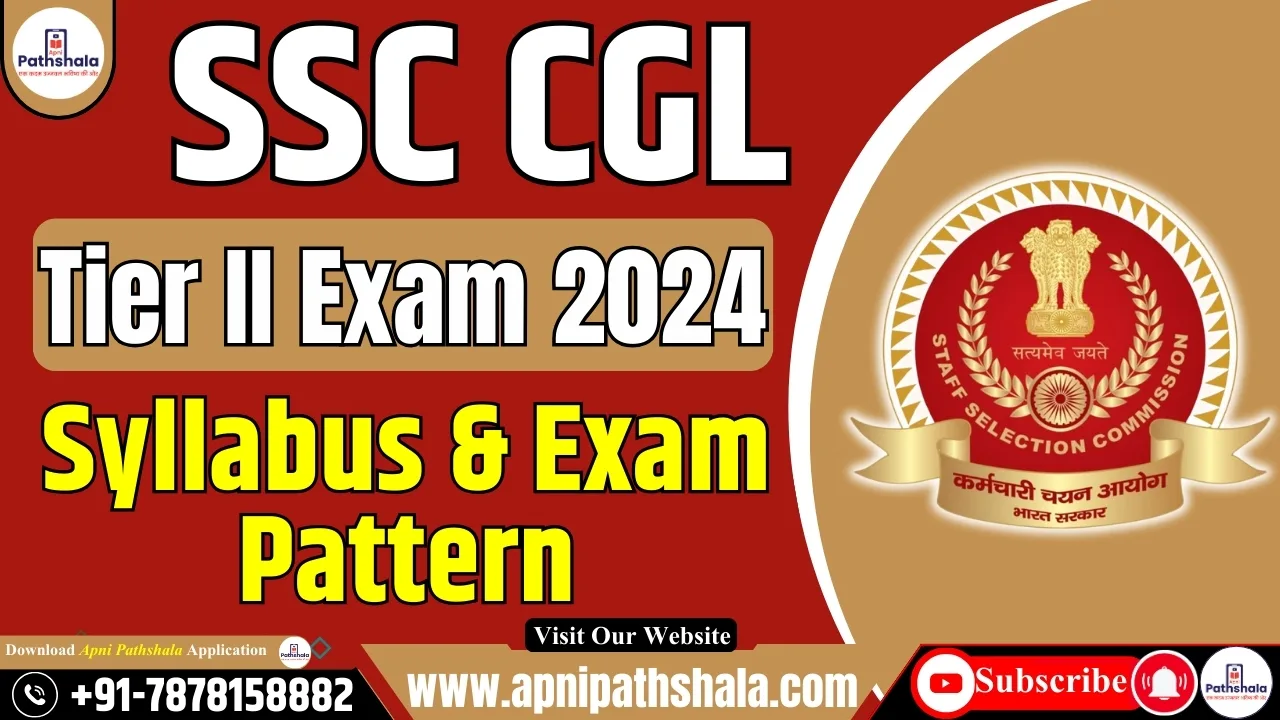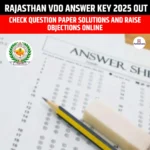SSC CGL Tier 2 Syllabus 2024 is divided into sections like Quantitative Aptitude, Reasoning, General Knowledge, and English Language. This article provides a detailed breakdown of the subject-wise syllabus.
SSC CGL Tier Exam 2024 Overview
Candidates preparing for the SSC CGL 2024 exam must thoroughly review the SSC CGL Tier 2 Syllabus and Exam Pattern before starting their preparation for the main exam. Understanding the syllabus is a crucial step to enhancing performance. Tier 2 exam is scheduled and candidates should focus on the key topics outlined in the syllabus. The SSC CGL syllabus for 2024 includes four major subjects: General Knowledge, Quantitative Aptitude, General Reasoning, and English Comprehension. Tier 2 will be conducted online.
SSC CGL Tier 2 Exam Pattern 2024
SSC CGL Tier 2 exam is conducted in two phases: Paper 1, which is compulsory for all candidates, and Paper 2, which is specifically for those applying for the Junior Statistical Officer (JSO) posts. Negative Marking for wrong answers in SSC CGL Tier 2 exam is: Paper I, Paper II, and Paper III, 1 mark will be deducted for each wrong answer.
|
SSC CGL Tier 2 Exam Pattern |
||
|
S. No. |
Papers |
Time Allotted |
|
1 |
Paper-I: (Compulsory for all posts) |
2 hours 30 minutes |
|
2 |
Paper-II: Junior Statistical Officer (JSO) |
2 hours |
Paper 1 (Compulsory for All Posts)
Paper 1 is divided into two sessions: Session I and Session II.
|
Paper 1 (Compulsory for All Posts) |
|||||||
|
Session |
Section |
Module |
Subject |
No. of Questions |
Marks |
Weightage |
Duration |
|
Session I |
Section I |
Module-I |
Mathematical Abilities |
30 |
90 |
23% |
1 hour |
|
Module-II |
Reasoning and General Intelligence |
30 |
90 |
23% |
|||
|
Session II |
Section II |
Module-I |
English Language and Comprehension |
45 |
135 |
35% |
1 hour |
|
Module-II |
General Awareness |
25 |
75 |
19% |
|||
|
Session III |
Section III |
Module-I |
Computer Knowledge Test |
20 |
60 |
Qualifying |
15 minutes |
|
Module-II |
Data Entry Speed Test |
1 Task |
Qualifying |
15 minutes |
|||
Paper 2 (For JSO and Statistical Investigator Posts)
This paper is for candidates applying for the Junior Statistical Officer (JSO) position or Statistical Investigator Grade-II.
|
Paper |
Section |
No. of Questions |
Maximum Marks |
Duration |
|
Paper II |
Statistics |
100 |
200 |
2 hours |
Note:
- Paper I is compulsory for all candidates and covers subjects like Mathematical Abilities, Reasoning, English Language, General Awareness, Computer Knowledge, and Data Entry.
- Paper II is for candidates applying for statistical roles and tests their knowledge in Statistics.
- The exam is conducted in online mode, with Paper I in two shifts and Paper II lasting 2 hours.
SSC CGL Tier 2 syllabus 2024
SSC CGL Tier 2 syllabus is divided into various sections, each focusing on different subjects depending on the paper. The syllabus includes Mathematical Abilities, Reasoning and General Intelligence, English Language, General Awareness, and specialized papers for specific posts. Here’s a detailed syllabus of SSC CGL Tier 2 syllabus:
Module-I of Session-I of Paper-I (Mathematical Abilities):
|
Topics |
|
|
Number Systems
|
|
|
Arithmetical operations
|
|
|
Algebra
|
|
|
Geometry
|
|
|
Mensuration
|
|
|
Trigonometry
|
|
|
Statistics and probability
|
Module-II of Section-I of Paper-I (Reasoning and General Intelligence):
|
Topics |
|
|
|
|
|
|
|
|
|
|
|
|
Module-I of Section-II of Paper-I (English Language And Comprehension):
|
Syllabus |
|
|
|
|
|
|
|
|
|
|
|
|
|
|
|
|
Module-II of Section-II of Paper-I (General Awareness):
|
Topics |
|
|
|
|
|
|
|
|
|
|
Module-I of Section-III of Paper-I (Computer Proficiency):
|
Topics |
|
|
|
|
SSC CGL Tier 2 Syllabus- Paper 2 (Statistics)
|
Subject |
Topics |
|
Collection, Classification and Presentation of Statistical Data |
Primary and Secondary data |
|
Methods of data collection |
|
|
Tabulation of data |
|
|
Graphs and charts |
|
|
Frequency distributions |
|
|
Diagrammatic presentation of frequency distributions |
|
|
Measures of Central Tendency |
Common measures of central tendency – mean median and mode |
|
Partition values- quartiles, deciles, percentiles. |
|
|
Measures of Dispersion- Common measures of Dispersion |
Range |
|
Quartile Deviations |
|
|
Mean Deviation |
|
|
Standard Deviation |
|
|
Measures of relative dispersion. |
|
|
Moments, Skewness and Kurtosis |
Different types of moments and their relationship |
|
the meaning of skewness and kurtosis |
|
|
different measures of skewness and kurtosis |
|
|
Correlation and Regression |
Scatter diagram |
|
simple correlation coefficient |
|
|
simple regression lines |
|
|
Spearman‟s rank correlation |
|
|
Measures of association of attributes |
|
|
Multiple regression |
|
|
Multiple and partial correlation (For three variables only). |
|
|
Probability Theory |
Meaning of probability |
|
Different definitions of probability |
|
|
Conditional probability |
|
|
Compound probability |
|
|
Independent events |
|
|
Bayes’ theorem. |
|
|
Random Variable and Probability Distributions |
Random variable |
|
Probability functions |
|
|
Expectation and Variance of a random variable |
|
|
Higher moments of a random variable |
|
|
Binomial |
|
|
Poisson |
|
|
Normal and Exponential distributions |
|
|
Joint distribution of two random variables (discrete). |
|
|
Sampling Theory |
Concept of population and sample |
|
Parameter and statistic |
|
|
Sampling and non-sampling errors |
|
|
Probability and nonprobability sampling techniques (simple random sampling, stratified sampling, multistage sampling, multiphase sampling, cluster sampling, systematic sampling, purposive sampling, convenience sampling and quota sampling) |
|
|
Sampling distribution (statement only) |
|
|
Sample size decisions. |
|
|
Statistical Inference |
Point estimation and interval estimation |
|
Properties of a good estimator |
|
|
Methods of estimation (Moments method, Maximum likelihood method, Least squares method) |
|
|
Testing of hypothesis |
|
|
Basic concept of testing |
|
|
Small sample and large sample tests |
|
|
Tests based on Z, t, Chi-square and F statistic |
|
|
Confidence intervals. |
|
|
Analysis of Variance |
Analysis of one-way classified data and two-way classified data. |
|
Time Series Analysis |
Components of time series |
|
Determination of trend component by different methods |
|
|
Measurement of seasonal variation by different methods. |
|
|
Index Numbers |
Meaning of Index Numbers |
|
Problems in the construction of index numbers |
|
|
Types of index number |
|
|
Different formulae |
|
|
Base shifting and splicing of index numbers |
|
|
Cost of living Index Numbers |
|
|
Uses of Index Numbers. |
|
Related Important Links |
|
SSC CGL Tier 2 Exam Date |
|
SSC CGL Tier 2 Syllabus & Exam Pattern |
|
SSC CGL Salary |
|
SSC CGL Tier 2 Cut Off |
|
SSC CGL Tier 2 Admit Card 2024 |
Explore our Books: https://apnipathshala.com/product-category/books/
Explore Our test Series: https://tests.apnipathshala.com/
























